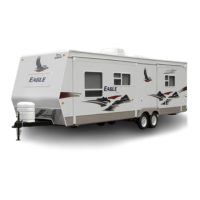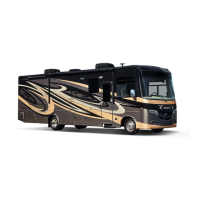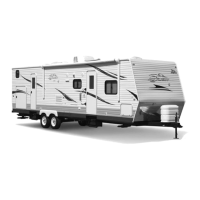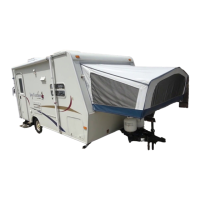CLASS C MOTOR HOMES SECTION 4 - VEHICLE OPERATION
4 - 9
Torque is the amount of rotating force applied to a fastener, such as a lug nut.
Proper torque of lug nuts can only be achieved by using a properly calibrated
torque wrench and socket. Do not use a 4-way socket or any other type of wrench
that does not measure the actual pressure applied to the lug nut.
NOTE: The proper method of tightening wheel lug nuts is with a torque
wrench, not with an impact wrench or by hand. Because of the importance of
having proper torque on the wheel lug nuts, you should always have the wheels
mounted and properly torqued by a qualified technician using the proper tools
After your first trip, check the wheel lug torque periodically for safety according to
your Chassis Guide. If you suspect the wheel lug nuts have loosened at any time,
have them checked and torqued to the proper limits immediately.
Check and re-torque after the first 10, 25 and 50 miles (16, 40 and 80
kilometers). Thereafter, check and maintain the torque according to the
listed torque values.
Wheel lugs
If you suspect or notice the wheel stud bolts are cracked or broken, they must be
replaced, along with adjacent bolts that have probably also been weakened due to
the additional stress placed on them.
W
HEEL BEARINGS & BRAKES
Follow the Chassis Guide maintenance instructions for the front and rear axle for
wheel and suspension maintenance, including the brakes and wheel bearings.
Contact your Chassis manufacturer for assistance.
EMERGENCY STOPPING
Always carry road flares or reflective warning signs to display if necessary. Pull off
the roadway as far as possible for emergency stopping. Turn ON your motor home
hazard warning flashers. If traveling at night, use three red warning indicators such
as flares, reflectors or lanterns, as follows:
1. Place the first warning indictor on the traffic side of the motor home, directed
at the nearest approaching traffic.
2. Place the second warning indicator 100 feet behind the motor home in the
center of the lane and toward approaching traffic.
3. Place the third warning indicator 100 feet in front of the motor home in the
center of the lane and away from the traffic approaching from behind.
The hazard-warning flasher provides additional safety if the motor home is
stopped on the side of the roadway and presents a possible hazard to other
motorists.
WARNING
Check and tighten the wheel lug nuts regularly to make sure they did not
loosen during travel. Refer to your Chassis Guide for Torque
recommendations. Failure to tighten and maintain wheel lug nuts to the
proper torque specification, could allow the wheels to come off while the
motor home is in motion, and could result in serious injury in the event of a
collision or loss of vehicle control.

